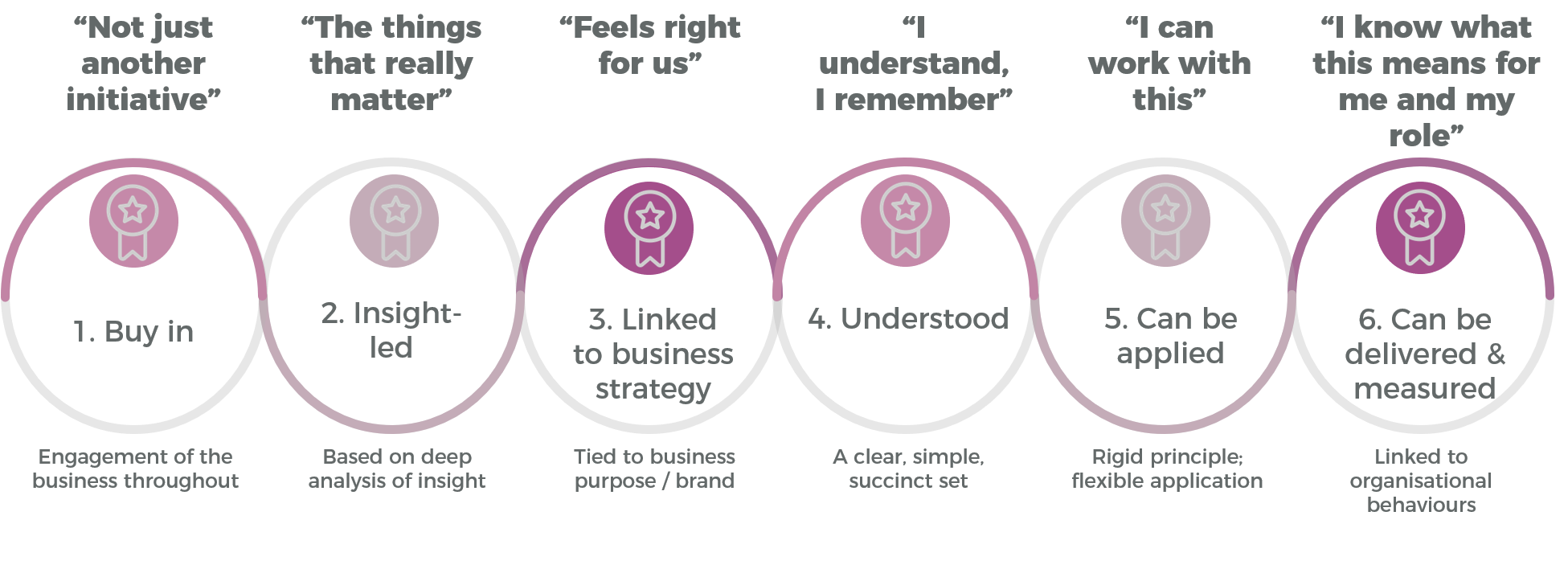CX Principles: What makes a good set?
In our last blog (‘CX Principles: Why bother?’) we discussed how and why businesses need Customer Experience (CX) Principles. Below we address another key question sometimes posed by our clients - ‘What makes a good set of CX Principles?’
In our experience, there are six key factors which determine their success:

1. Buy-in
To deliver a good CX on the ‘front stage’, it is critical to develop the right attitudes and culture ‘back stage’. Stakeholders and employees need to be engaged with and bought into the CX Principles from the offset and, specifically, need to be fully aware of:
- Why the CX Principles are required / how they will add value to the business
- How they will be developed (and how colleagues will be engaged in this process)
- How they will be applied and used
Communication and on-going colleague engagement in the development of the principles fosters buy-in, which in-turn engenders a culture of cross-functional working, ownership, and accountability - factors which are critical when it comes to the implementation/ roll-out stage.
2. Insight-led
It may sound like an obvious point…but Customer Experience Principles need to be customer-led and built from the bottom-up. More specifically, they should:
- Start from customer ‘ideals’ derived from primary research with customers
- Be grounded in human universals/ innate needs and the customer’s desired emotional state – i.e. how they want to feel as a result of their experience with your brand
- Be built upon and refined using/ via:
- Existing sources of data and insight across the business, with customer verbatims and sentiment analysis proving critical in this context (e.g. from your VoC programme, complaints data, and customer reviews)
- Input from a cross-functional group of colleagues, with collaborative sessions used to challenge, refine, and further develop key themes identified through insight and analysis
3. Linked to business strategy
Whilst it is essential that the principles are both customer and insight-led, it is also critical that they are aligned to the overall business direction. The customer ideals, identified via customer insight, should therefore be reviewed through the lens of the overall business strategy to arrive at the delivery of an experience which is also right for, and representative of, the business and what it stands for.
For example; when describing the ideal airline experience, leisure customers may want to feel ‘special’/ ‘valued’ and describe tangible aspects of the experience such as a complimentary limousine service, being greeted by air hostesses with free champagne, and/or their own private area in the cabin as delivering on this. However, these features are not aligned to a low-cost airline’s proposition; so, for a low-cost carrier, the question then becomes, ‘What can we do to make our customers feel special/ valued (within the realms of our proposition)?’
4. Understood
For principles to be embedded effectively across an organisation, they need to be universally understood and, like the CX vision (discussed in last week’s blog), not left open to interpretation. To be understood, the principles need to be:
- Clearly defined and brought to life through real life examples (customer scenarios), which make sense to both frontline and back office colleagues
- Memorable – employees are not going to remember a list of 20+ principles! In our experience, 3-6 overall/ ‘headline’ principles are optimum (though these will have underlying attributes that explain how they will be delivered). The business may then also consider ways to keep its principles top of mind; for example, this may include a mnemonic and/or ongoing engagement tools such as a customer room, short films, and posters/ artwork around the premises
5. Can be applied
In order for CX Principles to be applied day-to-day it is critical that the framework is:
- Rigid yet flexible - i.e. supports a consistent CX whilst also allowing sensible flexibility to account for nuances across brands, customer journeys, products, services, and channels, etc.
- Realistic – i.e. built upon a realisation that things sometimes go wrong (even for brands that are leaders in CX). In fact, putting the customer back in a better place than where they started can result in a happier customer. Principles therefore need to consider both the ‘happy’ and ‘unhappy’ paths, with a plan for turning a negative CX into a positive one
- Holistic - in a world where customer expectations and tech are simultaneously evolving, CX Principles need to deliver on the desired experience of both today and tomorrow. (As well as accounting for the very basic elements of the CX/ ‘hygiene factors’), a good set of principles will include aspirational attributes – things that the business may not necessarily be set-up to achieve right now…but elements that it aspires to achieve in the future, feeding directly into customer journey design
6. Can be delivered and measured
Finally, to prove the added value of CX Principles (and to ensure they continue to drive customer-led change), they need to be:
- Linked to organisational behaviours – with a clear link between touchpoints and how they make customers feel, bringing to life the impact that colleagues from across the business have on the CX
- Embedded and part of BAU, including change processes, journey design and re-design, and SLAs with suppliers, etc.
- Part of the internal measurement process – with colleagues asked to evidence how they’re delivering against them as part of the employee renumeration process
- Part of the external measurement process – with performance against principles and their role in driving key metrics (e.g. NPS/ CSAT/ CES) understood on an ongoing basis
Do you have experience of developing/ embedding CX Principles within your organisation? We’d love to hear your thoughts and experience in terms of what’s key to driving success…

